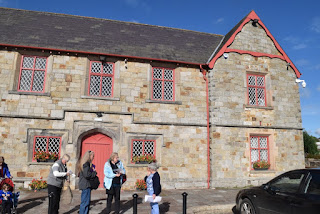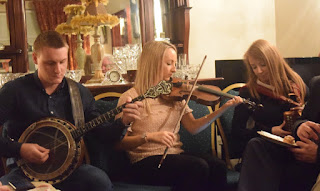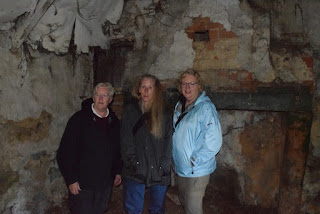South County Armagh
On Saturday, we headed north, going
most of the distance on the M50 motorway (freeway). Richard felt
better about driving on the left side of the road, having gotten in
some driving, and also having lighter traffic. We drove on
progressively smaller and curvier roads, finally ending up on the Bog
Road; in some places the road too narrow for two cars to pass. We
found our lodging, Ti Chulainn Cultural Center. We settled into
rooms that were comfortable, but not too fancy.
Our wifi hotspot, which had worked very
well at Glendalough, quit working when we crossed the border into
Northern Ireland, despite the promise from Hertz that it would work
north of the border. Ti Chulainn has WIFI, but it is a bit erratic.
After getting unpacked, in late
afternoon, we drove to find the relatives, based on their street
address, only to get frustrated with roads with unmarked names, and
house numbers that did not seem helpful. We returned to Ti Chulainn,
where they called the relatives, and Patrick came to lead us to their
house. The house was full of relatives, and they had put out a large
spread of food. It was quite a larger greeting than we had expected.
Dermot and Ann, the parents, have four children, and we met all of
them, as well as their spouses or boyfriends/girlfriends. Dermot
pulled out an old photo album, and they found a photo of Sandi's
family, as stairstep kids in identical outfits. At that point,
Dermot realized who we were, and that his mother had been
corresponding with Sandi's mother.
 |
| Dermot and Ann |
We met with a Kevin, a local historian
and geneaologist, who was instrumental in building the cultural
center. We learned about land records, and transfer of the land from
the British landlords to their tenants. We also learned about the
area history. The famine was so painful, that most Irish people who
stayed did not talk about it. The history of the famine comes from
the people who emigrated. The various Irish revolts were largely
financed by the people who had emigrated. This meeting was very
informative and interesting.
In the evening, they threw a party,
which included food, and traditional Irish music, with a banjo, a fiddle, and a
button accordion, all played by family members. Peg later joined in
with a borrowed guitar. Most of the music was instrumental, but as
the evening went on, people began to sing. Generally, one person
would sing a song, reading the lyrics off an iPad. The songs were mostly sad ballads, although at least three songs related to the
troubles. The music went on until midnight.
South Armagh is a borderland, and they
live just a few miles from the Republic of Ireland. The area is
heavily Catholic, although it is within Northern Ireland, which is
mostly Protestant. The troubles impacted this area heavily. Ti
Chulainn even has a monument to the IRA fighters who died fighting
the British.
On Sunday, we met at St. Mary's church,
where we found the building in excellent condition, and packed with
people. We were surprised to see so many people in church; there was
a traffic jam in the little town. After mass, Peg played the organ a
little; we walked the cemetery, where we found the family plot. The
custom here is to bury people in wooden caskets, and let the bodies
decay. When the next family member dies, they hand dig the grave,
gather up any bones that they find, and put them back, along with the
new casket. They often put up a large stone, with plenty of blank
spaces to add future names.
After church, we put on rubber boots
and walked the family land. The most poignant part of the day was a
visit to the house where Dermot lived until he was nine years old, where the family lived for generations. It is a stone house with a thatched roof and three rooms. The house
had a dirt floor, and was their home until 1954, when they took out a
mortgage to build a modern house. There were eight people sleeping
in one room, with no plumbing, no toilet or outhouse, and a well with a bucket.
This was subsistence farming, largely not in the cash economy, although they sold eggs to make a few dollars to buy shoes. Dermot said that they lived no differently than any of their neighbors. They helped each other with the harvest. They had no horses or vehicles; they had a few acres of land, which kept them alive. This was very moving to all of us. Dermot told the story in a very matter of fact manner. The three brothers who came to the United States in the late 1800s grew up in this house. Today we would call them refugees or perhaps economic migrants, escaping poverty.
This was subsistence farming, largely not in the cash economy, although they sold eggs to make a few dollars to buy shoes. Dermot said that they lived no differently than any of their neighbors. They helped each other with the harvest. They had no horses or vehicles; they had a few acres of land, which kept them alive. This was very moving to all of us. Dermot told the story in a very matter of fact manner. The three brothers who came to the United States in the late 1800s grew up in this house. Today we would call them refugees or perhaps economic migrants, escaping poverty.
Later in the afternoon, Dermot's son
Dermot took us on the scenic road on the nearby peak, Slieve Gullion.
It is a one way loop road, with views of the Irish Sea and the
valley. The weather was coming in, and we were treated to a
fabulous rainbow.
We took Dermot and Ann to dinner in Warrenpoint. We said goodbye to Mike and Susan, who were headed north.
Monday morning we decided to head for
Armagh city, where we visited St. Patrick's Cathedral, reportedly founded by St. Patrick himself. Armagh is still the seat of the Cardinal in Ireland.
On the way back, we stopped in Carrickcross, and got a tour of the poorhouse, or workhouse, which provided a last resort during the famine.
 |
| Workhouse |
In the evening we had a second meeting with Kevin, where we learned more of the history of the area, including the famine. We had dinner late at the local chips and Chinese restaurant.











No comments:
Post a Comment